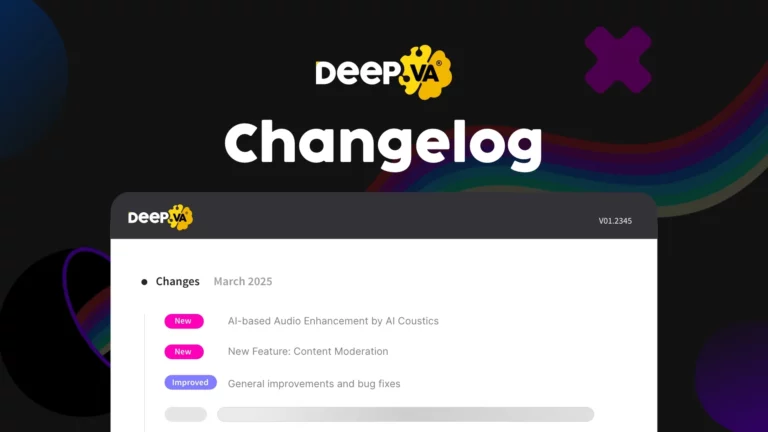Impacts of the EU Accessibility Act on the Media Industry
In June 2025, stricter accessibility laws will come into effect in the EU, known as the European Accessibility Act (EAA). These new regulations aim to improve access to digital products and services, affecting both public and private companies in the EU, with fines of up to 100,000 euros for non-compliance.
The EAA focuses on creating unified accessibility requirements to improve access for people with disabilities. This includes audiovisual media, e-books, telecommunications services, and e-commerce. The goal is to break down barriers, facilitate cross-border trade, and provide a wider range of accessible products and services at competitive prices.
The Potential of AI for Accessibility
One of the most promising technologies supporting accessibility in the media sector is Artificial Intelligence (AI). Particularly in the fields of transcription and live transcription, AI shows great potential. These technologies enable the creation of real-time subtitles, thus supporting deaf and hard-of-hearing individuals. This functionality is not limited to audiovisual works but can also be used at events and lectures. AI significantly reduces the costs and effort associated with manual transcription and subtitling.

Transcription and Live Transcription
Products like the Deep Live Hub automatically convert spoken language into text, creating the basis for subtitles. Live transcription takes this a step further by enabling real-time subtitling of spoken content. This is especially useful for live broadcasts, news, and sports transmissions, where information needs to be conveyed immediately and accurately. A study by the European Audiovisual Observatory emphasizes that the introduction of such technologies is crucial for meeting the requirements of the EAA.
The Association of Commercial Television in Europe (ACT) stresses that a market-oriented approach is best suited to providing accessible services without jeopardizing economic viability. According to their market survey (link to PDF document) of television broadcasters in Europe, the average costs for subtitling are around 284.00 EUR per hour, for sign language interpretation 570.00 EUR, and for audio description approximately 568.50 EUR per hour. It remains unclear whether AI-based services were also examined. ACT emphasizes that regulatory requirements must not become a mere “tick-box exercise” but should foster innovation and the development of new accessible services, as exemplified in France.

Accessibility goes beyond Programming
It includes providing subtitles and audio descriptions for audiovisual content as well as sign language interpreting to enable access for the deaf and hard of hearing, but it goes even further: websites and mobile applications must comply with the Web Content Accessibility Guidelines (WCAG), which include ALT texts for images, structured content, and appropriate contrasts. Here too, AI can help: ALT texts for images can be automated with Deep Media Analyzer (face recognition, object recognition) and LLM with Composite AI.
Knowledge Transfer to other Sectors
Our AI-based technologies can also be used in other areas such as events or public services. Events can be made more accessible through real-time transcription and subtitling via the Deep Live Hub, for which we recently published a Customer Success Story. In the public sector, information and services can be made more accessible with AI-based tools, promoting integration and participation of all citizens. For example, communication barriers on the phone and in customer support can be actively reduced.
“When we design for disability first, you often stumble upon solutions that are better than those when we design for the norm
Elise Roy
Disability rights lawyer & design thinker
Current State of Accessibility of Audiovisual Content
Some countries have already introduced exemplary measures for the accessibility of their content. Denmark and Sweden place great importance on high legal standards and the continuous improvement of accessibility. Denmark has integrated the principles of Universal Design into the contract for public broadcasting and has already introduced sanctions for breaches of accessibility requirements. Sweden has high subtitling quotas and actively promotes the availability of audio descriptions for its programs.
In contrast, some countries like Luxembourg and Malta still have room for improvement. Luxembourg lacks specific measures for accessibility, and progress in implementing new regulations in Malta is limited. Overall, however, the media sector can be credited with a high level of accessibility.
Conclusion
“When we design for disability first, you often stumble upon solutions that are better than those when we design for the norm” says Elise Roy, disability rights lawyer and design thinker.
The European Accessibility Act presents both a significant challenge and an opportunity for the media industry. The initial steps signal a positive trend, promising benefits for both companies and consumers. Timely implementation of accessibility measures is essential and should be integrated into product development from the outset. Accessibility is evolving from a “nice-to-have” to a “must-have,” a shift that is not only correct but crucial for integration. By leveraging AI-supported transcription and descriptive services, companies can meet legal requirements while also enhancing their reach and inclusivity.





